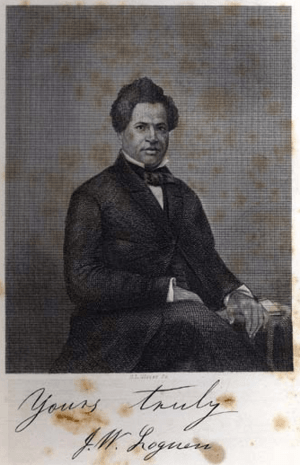Jermain Wesley Loguen facts for kids
Quick facts for kids
Jermain Wesley Loguen
|
|
|---|---|

Bishop Jermain Loguen, 1835
|
|
| Born |
Jarm Logue
February 5, 1813 |
| Died | 30 September 1872 (aged 59) |
| Occupation | Abolitionist, Public speaker Bishop of the African Methodist Episcopal Zion Church |
| Spouse(s) | Carolyn Storum |
| Children | Sarah Loguen Fraser |
Jermain Wesley Loguen (born February 5, 1813 – died September 30, 1872) was an important African-American leader. He was born into slavery as Jarm Logue. Later, he became a strong voice against slavery, known as an abolitionist. He also became a bishop in the African Methodist Episcopal Zion Church. Loguen wrote a book about his life as a slave, sharing his powerful story with the world.
Contents
Jermain Loguen's Early Life and Freedom
Jarm Logue was born in Davidson County, Tennessee. His mother, Cherry, was an enslaved woman. His owner, David Logue, was his father. When he was 21, Jarm escaped from slavery. He changed his name to Jermain Wesley Loguen. He added the "n" to his last name.
Loguen taught himself to read and write. This was a huge achievement for someone who had been enslaved. He worked many different jobs in Canada and New York. He also studied at the Oneida Institute in Whitesboro, New York. This school was known for supporting equal rights. After his studies, Loguen opened schools for Black children. He started these schools in Utica and Syracuse, New York.
From 1845 to 1846, Loguen served as a minister. He worked at the St. James AME Zion Church in Ithaca, New York.
The Underground Railroad and Church Work
Jermain and his wife, Caroline Loguen, played a big role in the Underground Railroad. This was a secret network that helped enslaved people escape to freedom. Their home in Syracuse was a major "depot" or safe stop. They even built a special "fugitive chamber" in their house.
The Loguen family openly helped runaway slaves. They gave them food, a place to wash, and a feeling of safety. If someone wanted to stay in the area, the Loguens helped them find a job. Jermain Loguen was known as the "'King of the Underground Railroad.'" Caroline was called his "queen."
Loguen became an elder in the African Methodist Episcopal Zion Church. He took the middle name Wesley after John Wesley. John Wesley was the founder of the Methodist movement. Loguen held many church positions. He was made a bishop in 1868.
Loguen became a very popular speaker against slavery. He wrote his life story in a book. It was called The Rev. J. W. Loguen, as a Slave and as a Freeman, a Narrative of Real Life (1859). Once, the wife of his former owner, Sarah Logue, demanded money from him. Loguen wrote a very strong reply. This letter was published in The Liberator, an important anti-slavery newspaper.
The Jerry Rescue Event
Loguen was involved in a famous event called the Jerry Rescue. This happened on October 1, 1851. A man named William Henry, also known as "Jerry," was arrested. He was a former slave. He was arrested under the Fugitive Slave Act of 1850. This law said that escaped slaves had to be returned to their owners.
A group of people who were against slavery, called the Liberty Party, were meeting in Syracuse. When they heard about Jerry's arrest, hundreds of abolitionists gathered. Both Black and white people worked together. They broke into the city jail and freed Jerry. This event became known as the Jerry Rescue.
After the rescue, some people accused Loguen of violence. They said he attacked a federal marshal. Loguen admitted he helped plan the rescue. But he said he did not join in the storming of the building. He also denied any violence. He was afraid of being sent back to slavery. So, he went to Canada for safety.
While in Canada, Loguen wrote letters. He wrote to the District Attorney, denying the charges. He also wrote to the Governor of New York. He said he would face trial if he was sure he wouldn't be captured and enslaved again. He did not get a reply to either letter.
After the trials ended, a newspaper article said Loguen would be safe in Syracuse. So, Loguen decided to return home. He felt confident that the Fugitive Slave Law was not working in Syracuse. He then ran the Underground Railroad openly. He even put announcements in newspapers. He advertised his address and shared how many people he helped.
Loguen's Family and Legacy
Jermain Loguen married Caroline Storum. She was born near Jamestown, New York. Caroline came from a free family that was against slavery. She was also educated.
Jermain and Caroline had six children. Their daughter, Amelia, married Lewis Henry Douglass in 1869. Lewis was the oldest son of the famous abolitionist Frederick Douglass. Amelia and Lewis shared their parents' passion. They worked for justice and education for enslaved and newly freed people.
After the Civil War, Lewis came home safely. Amelia and Lewis joined the Loguen family in Syracuse. They taught children and helped families reunite. Many families were broken after slavery. In the early 1860s, Amelia helped her father. She taught children in Binghamton, NY. She often used her own money to help. She also held night classes for adults. These classes were at the AME Zion church in Binghamton.
Another daughter, Sarah Loguen Fraser, made history. She became one of the first African-American women to be a licensed doctor. Later, she became the first female doctor in the Dominican Republic. The Loguen family left a lasting legacy of fighting for freedom and education.


